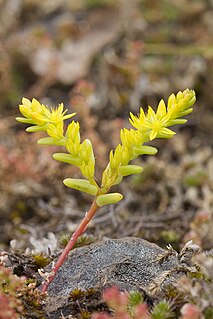
Lepidoptera is an order of insects that includes butterflies and moths. About 180,000 species of the Lepidoptera are described, in 126 families and 46 superfamilies, 10 per cent of the total described species of living organisms. It is one of the most widespread and widely recognizable insect orders in the world. The Lepidoptera show many variations of the basic body structure that have evolved to gain advantages in lifestyle and distribution. Recent estimates suggest the order may have more species than earlier thought, and is among the four most speciose orders, along with the Hymenoptera, Diptera, and Coleoptera.

The geometer moths are moths belonging to the family Geometridae of the insect order Lepidoptera, the moths and butterflies. Their scientific name derives from the Ancient Greek geo γη or γαια 'the earth' and metron μέτρων 'measure' in reference to the way their larvae, or inchworms, appear to "measure the earth" as they move along in a looping fashion. A very large family, it has around 23,000 species of moths described, and over 1400 species from six subfamilies indigenous to North America alone. A well-known member is the peppered moth, Biston betularia, which has been subject of numerous studies in population genetics. Several other geometer moths are notorious pests.

The Pyralidae, commonly called pyralid moths, snout moths or grass moths, are a family of Lepidoptera in the ditrysian superfamily Pyraloidea. In many classifications, the grass moths (Crambidae) are included in the Pyralidae as a subfamily, making the combined group one of the largest families in the Lepidoptera. The latest review by Eugene G. Munroe & Solis, in Kristensen (1999) retains the Crambidae as a full family of Pyraloidea.

Louis William Valentine Dubourg was a Sulpician bishop of the Roman Catholic Church in the early years of the United States in St. Louis, Missouri, and later an Archbishop in France.

The Pyraloidea are a moth superfamily containing about 16,000 described species worldwide, and probably at least as many more remain to be described. They are generally fairly small moths.

The de Havilland DH.60 Moth is a 1920s British two-seat touring and training aircraft that was developed into a series of aircraft by the de Havilland Aircraft Company.

Nepticulidae is a family of very small moths with a worldwide distribution. They are characterised by eyecaps over the eyes. These pigmy moths or midget moths, as they are commonly known, include the smallest of all living moths, with a wingspan that can be as little as 3 mm in the case of the European pigmy sorrel moth, but more usually 3.5–10 mm. The wings of adult moths are narrow and lanceolate, sometimes with metallic markings, and with the venation very simplified compared to most other moths.

Schinia, commonly called flower moths, is a large genus of moths belonging to the family Noctuidae. The genus has a Holarctic distribution with the vast majority of species being found in North America, many with a very restricted range and larval food plant.

Sedella is a town and municipality in the province of Málaga, part of the autonomous community of Andalusia in southern Spain. The municipality is situated approximately 54 kilometres from the provincial capital of Málaga, 23 from Vélez-Málaga and 8 from Canillas de Aceituno. It has a population of approximately 500 residents. The natives are called Sedellanos. The Patron Saint is St Andrew the Apostle. The village church has a bell tower dating back to Moorish time. Other signs of Moorish origin can also be found in one of the last bastions of the Moors. Sedella is also the Center for the Nature Park of Sierra Tejeda and Almijara with a Visitor Centre. The annual summer fiesta is in honour of the Virgin Mary of Esperanza (Hope).

Yponomeuta sedella is a moth of the family Yponomeutidae. It is found in Europe.

Sedella is a small genus of flowering plants in the stonecrop family. There are approximately 7 species, all native to California, United States, one with a distribution extending into Oregon. These are petite succulent plants growing a few centimeters tall and bearing tiny yellowish or brownish flowers. Mock stonecrop is a common name for these plants.
Sedella congdonii is a species of flowering plant in the stonecrop family known by the common name Congdon's mock stonecrop. It is endemic to California, where it can be found in the Sierra Nevada, often in rocky and moist habitat types. It is an annual herb growing just a few centimeters high. The oval succulent leaves are just a few millimeters long. The flowers occur in a cyme on thin branches. Each has yellow petals no more than 3 millimeters long.
Sedella leiocarpa is a rare species of flowering plant in the stonecrop family known by the common names Lake County mock stonecrop and Lake County stonecrop. It is endemic to Lake County, California, where it is known from only about ten occurrences in two locations. It is a resident of drying vernal pools and rocky clay flats, where it grows in colonies. It is a federally listed endangered species. This is an annual herb growing no more than four centimeters high. It is a tiny erect reddish or yellow succulent plant with sparse leaves each a few millimeters long. The flowers have yellow to reddish petals 3 or 4 millimeters long.
Sedella pentandra is a species of flowering plant in the stonecrop family known by the common name Mt. Hamilton mock stonecrop. It is endemic to California, where it grows in the Central Coast Ranges and adjacent sections of the Central Valley and coastline. It often grows on sandstone and serpentine soils. This is an annual herb growing no more than 8 centimeters high. It has small succulent leaves each a few millimeters long. The flowers atop the threadlike stems have fleshy sepals and yellowish petals a few millimeters in length.

Sedella pumila is a species of flowering plant in the stonecrop family known by the common name Sierra mock stonecrop. It is native to California, where it grows in the North Coast Ranges and adjacent sections of the Central Valley to the Sierra Nevada foothills. It is a plant of vernal pools and similar habitat, growing in rocky and gravelly flats of serpentine soils, limestone, and soils of volcanic origin, often alongside mosses. This is an annual herb growing 2 to 17 centimeters high, in shades of green, yellow, and red. It has small knobby succulent leaves each a few millimeters long. The flowers atop the threadlike stems have fleshy sepals and yellowish petals a few millimeters in length. The flowers have a musty scent.

The Erebidae are a family of moths in the superfamily Noctuoidea. The family is among the largest families of moths by species count and contains a wide variety of well-known macromoth groups. The family includes the underwings (Catocala); litter moths (Herminiinae); tiger, lichen, and wasp moths (Arctiinae); tussock moths (Lymantriinae), including the arctic woolly bear moth ; piercing moths ; micronoctuoid moths (Micronoctuini); snout moths (Hypeninae); and zales, though many of these common names can also refer to moths outside the Erebidae. Some of the erebid moths are called owlets.

Cauchas is a genus of the fairy longhorn moth family (Adelidae). Among these, it belongs to subfamily Adelinae. The taxon Cauchas was originally created as a subgenus of the genus Adela but was raised to the genus level in 1980.
Callophrys mossii, the Moss's elfin, stonecrop elfin and Schryver's elfin), is a butterfly native to North America that belongs in the family Lycaenidae. It is found from British Columbia south to southern California and east to Wyoming and Colorado in isolated populations. The habitat consists of rocky outcrops, woody canyons and cliffs.

Antonio de Sedella, O.F.M. Cap. was a Spanish Capuchin friar who served as the leading religious authority of the Catholic Church in New Orleans, Louisiana, during the late 18th and early 19th centuries. Commonly called Père Antoine, he has become a noted figure in the culture of the city. His ghost is said to walk an alley now named for him which runs alongside the city's cathedral. A street and a restaurant in the city's historic French Quarter are named for him.















